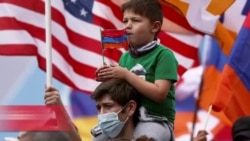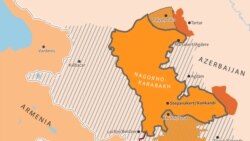On April 24, the Azerbaijani Foreign Ministry protested remarks made by U.S. President Joe Biden on Armenian Remembrance Day.
Biden issued a statement commemorating the 107th anniversary of the start of the genocide, in which between 600,000 and 1.5 million Armenians died though various atrocities during World War One, including executions, forced migration and abuse and neglect in concentration camps.
More than 20 countries worldwide officially recognize the Armenian genocide, including the United States, Argentina, Brazil, Belgium, Canada, France, Germany and Russia.
In 2019, the U.S. Congress passed a resolution “affirming the historical facts of the Armenian Genocide perpetrated by the Ottoman Empire, and honoring the memories of its 1,500,000 victims.”
Azerbaijan’s Foreign Ministry said the White House distorted history.
“The attempts to misrepresent the events that happened a century ago and politicize the so-called ‘Armenian genocide’ are unacceptable.”
That is false. There is no misrepresentation.
Biden was the first U.S. president to officially use the term genocide in reference to the massacres of Armenians in that era. Previous presidents refrained from using it to avoid complicating relations with Turkey, a NATO defense member allied with the U.S. and European nations.
Turkey maintains that the mass killings and treatment of Armenians of 1915-17 are exaggerated or the result of armed conflict and were not a systematic campaign of extinction.
The Azerbaijan Foreign Ministry's statement is in line with Turkey’s view. Turkey also rejected Biden’s April 24 statement, saying it was “incompatible with historical facts.”
The genocide, however, has been thoroughly documented.
Armenians are an ethnic group native to Armenia region, which is comprised of northeastern Turkey and the neighboring republic of Armenia. Mostly Christian, they faced historic religious persecution during Russian campaigns against the Persians and Turks in the 18th and 19th centuries.
In the start of the 20th century, about 2.5 million Armenians lived in the once-dominant Ottoman dynasty. The centuries old regional power was crumbling after a series of military defeats, and in 1908, a group of army officers, the Young Turks, seized power and started taking measures against Armenians.
By 1914, the Young Turks had sided with Germany during World War I against Britain, France and Russia. They portrayed the Armenians as a pro-Russian “fifth column” and inside threat.
By scholarly and many other accounts, the genocide began in April 1915 with the arrests of Armenian intellectuals and politicians, followed by mass executions and the systematic deportation of Armenians, who were sent in convoys on a 600-mile journey to camps in Syria.
The Armenian Film Foundation archive contains testimony from 400 Armenian genocide survivors, recorded between 1972 and 2005, including the story of Haroute Aivazian, who was age 10 when the genocide began.
His account, recorded in 1993 in Britain, was archived by the University of Southern California Shoah Foundation, a nonprofit that compiles audio-visual interviews with survivors of the Holocaust and other genocides.
Aivazian said that even though his father had served in the Ottoman army, authorities still confiscated his family’s vineyard in the town of Marash and deported the family. His mother, knowing they might be marched to their deaths, dropped off Haroute and his brother in an orphanage built by German missionaries for Armenian children.
Later, Haroute’s father returned to Marash to learn that his wife had been deported to Iskenderun in Turkey. Many didn't survive the harsh winter conditions, though Haroute’s mother was an exception.
“Even though I did survive, we lost something very precious, something which is the birthright of every person, childhood. We lost our childhood, and even now I have nightmares about it,” Haroute says in his account.
Descendants of survivors also have documented their families’ stories.
In 2016, Nouritza Matossian, a British-Armenian, told the BBC that her family was among those deported from Gaziantep in Turkey to Deir ez-Zour in Syria. “Driven across these deserts starving, without water, stripped naked, their clothes were torn off their backs everything was taken from them,” said Matossian.
About 100,000 descendants of deported Armenians still lived in Syria before the 2011 civil war broke out between rebels and the Bashar Assad regime.
Hundreds of news articles reporting on the Armenian genocide were published between 1915 and 1923, including in U.S. newspapers like The New York Times and The Washington Post. Many of those articles described the horrific treatment of Armenians.
In the 1916 Oregon Journal report, the paper’s correspondent wrote that men were simply assassinated en masse, while the elderly, women and children were dispatched to the Syrian desert.
“The tortured progress of these unfortunates, at the mercy of their brutal gendarme escorts who attacked them on the road, affords one of the most poignant pages in history,” the story said.
An archive of photographs, most collected by the Armenian National Institute in Washington, visually documents the atrocities Armenians suffered.
In 1920, after the Ottomans' demise, the Soviet Red Army invaded Armenia and local communists took power. Only after the dissolution of the Soviet Union in late 1991 did Armenia gain independence.
Now, Azerbaijan has close ties with Turkey and a hostile relationship with neighboring Armenia due to a dispute over the Nagorno-Karabakh region.
In a breakout of armed hostilities between Azerbaijan and Armenia two years ago, hundreds of soldiers have been killed on both sides. Nagorno-Karabakh officials said 1,177 of their troops and 50 civilians were killed. The United Nations children’s agency said 130,000 civilians have been displaced.
Nagorno-Karabakh is a predominantly Armenian area. The Soviets had established the region as autonomous, but in 1988 the region’s legislature decided to join Armenia.
The International Association of Genocide Scholars reports that more than 1 million people were killed in the Armenian genocide, based on numerous studies.
“We want to underscore that it is not just Armenians who are affirming the Armenian Genocide but it is the overwhelming opinion of scholars who study genocide,” the IAGS wrote in 2005 in a letter to Recep Tayyip Erdogan, who was then Turkey’s prime minister and is now president.







